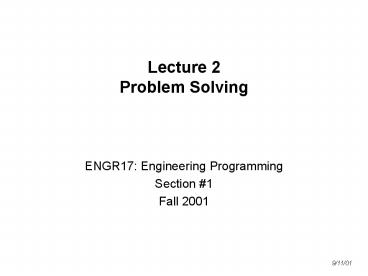Lecture 2 Problem Solving - PowerPoint PPT Presentation
1 / 35
Title:
Lecture 2 Problem Solving
Description:
Lecture 2. Problem Solving. ENGR17: Engineering Programming. Section #1. Fall ... Hints for Writing Algorithms. 6/4/09. ENGR17: Engineering Programming. 15 ... – PowerPoint PPT presentation
Number of Views:212
Avg rating:3.0/5.0
Title: Lecture 2 Problem Solving
1
Lecture 2Problem Solving
- ENGR17 Engineering Programming
- Section 1
- Fall 2001
9/11/01
2
Outline
- Six problem-solving steps used to create a
computer program - Complete an IPO chart
- Plan an algorithm using pseudocode and flowcharts
- Desk-check an algorithm
- Code and execute the algorithm
3
Creating Computer Solutions
4
Analyzing the Problem
- Determine the output(goal or purpose of solving
the problem) - Determine the input(information needed to reach
the goal) - Use an IPO (Input, Processing, Output) chart to
organize and summarize the results of problem
analysis
5
Analyzing the Problem
6
Analyzing the Problem
- Most difficult problem-solving step
- Problem specification can contain too much or too
little information - Distinguish between information that is missing
in the problem specification, and information
that is not explicitly stated
7
Analyzing the Problem
8
IPO Chart
9
Analyzing the Problem
10
Planning the Algorithm
- Algorithm the steps that will transform the
input into the output - Enter input items
- Process the data (usually by doing some
calculations) - Print or display the output items
- Tools
- IPO chart
- Pseudocode
- Flowcharts
11
Planning the Algorithm
12
Pseudocode Flowcharts
- Use standardized symbols, connected with
flowlines, to show the steps the computer needs
to take to accomplish the programs goal
Start/Stop
Process
Input/Output
13
(No Transcript)
14
Hints for Writing Algorithms
15
Hints for Writing Algorithms
16
Hints for Writing Algorithms
17
Hints for Writing Algorithms
18
Hints for Writing Algorithms
19
Desk-checking the Algorithm
- Refers to completing each step in the algorithm
manually, using a set of sample data for input
values - Verifies that the algorithm is not missing steps
- Verifies that the existing steps are correct and
in the proper order - Also called hand-tracing
- Can use a desk-check table
20
Desk-checking the Algorithm
21
Desk-checking the Algorithm
22
Desk-checking the Algorithm
23
Problem Solving Summary
- Problem-solving steps used to create a computer
program - Analyze the problem
- Plan the algorithm
- Desk-check the algorithm
- Code the algorithm into a program
- Desk-check the program
- Evaluate and modify the program
- IPO charts
- Planning an algorithm using pseudocode and
flowcharts - Desk-checking an algorithm
continued
24
Completing the Problem-Solving Process
25
The C Programming Language
- Object-oriented successor to the
procedure-oriented C language - C language
- 1972, Dennis Ritchie, Bell Laboratories
- C
- 1985, Bjarne Stroustrup, Bell Laboratories
- Can be used as a procedural as well as an
object-oriented language
26
Requirements for Creating C Program
- Text editor
- Used to enter the C instructions (source code)
- C compiler
- Converts source code into machine code (object
code) - Case sensitive
27
Different C Systems
- Integrated Development Environment (IDE)
- Contain editor and compiler in one integrated
environment - Examples Microsoft Visual C, Borland C
Builder - Command-line compilers
- Contain only the compiler
- Require use of general purpose editor (NotePad,
WordPad) to enter program instructions
28
Coding the Algorithm
- Coded algorithm a program
- Starting Microsoft Visual C 5.0
29
Program Instructions
30
C Programs
- Use a precise syntax
- Can include comments (//)
- Contain at least one directive
- Must contain a function named main
31
Other Coding Terminology
- Header files (.h)
- Keywords
- Functions and void functions ( and )
- Variables
- Statements ()
- Streams (cout and cin)
- Insertion operators (()
- Stream manipulators
32
Evaluating and Modifying the Program
- Testing
- Execute the program and enter sample data
- Valid data
- Invalid data
- Debugging
- Locate and remove errors in a program
- Syntax error
- Logic error
33
Executing a C Program
- Before it can be executed, a C program must be
compiled (source code translated into object code)
34
After Completing Program
- Assemble external documentation and keep in a
safe place - IPO chart
- Flowchart of pseudocode
- Printout of the program
35
Programming Summary
- Origins of the C programming language
- Source code and object code
- Opening a C source file
- Coding an algorithm
- Compiling, building, and executing a C program
- Evaluating and modifying a program































